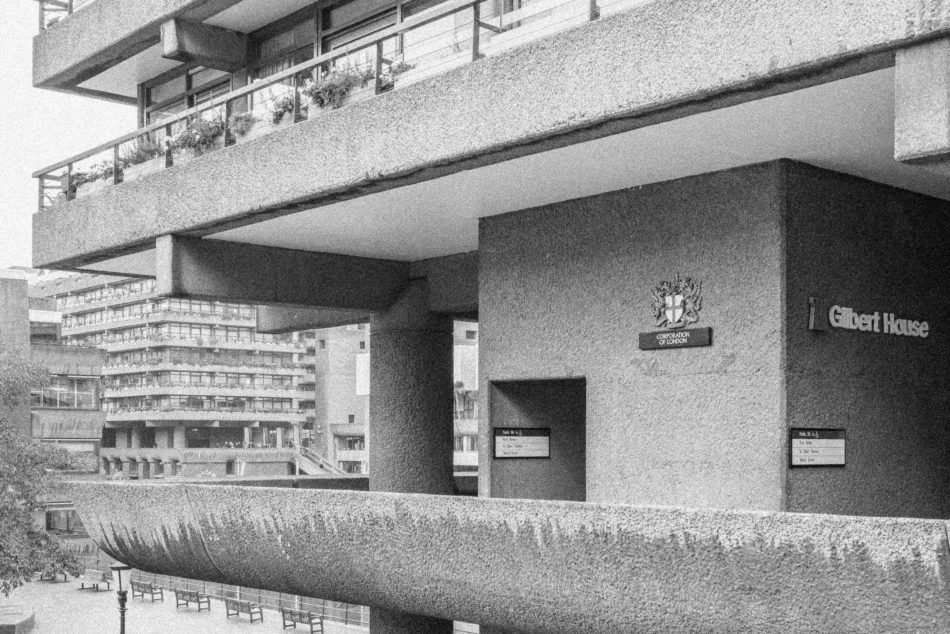












Gilbert House
Barbican, London EC2
Architect: Chamberlin, Powell & Bon
Register for similar homes"A totally complete, stonkingly powerful, three-dimensional city, wrapped around a sumptuous landscape of green squares and lakes," - Piers Gough
This one-bedroom apartment is positioned on the fourth floor of Gilbert House in the Barbican. Originally completed in 1969, Gilbert House is raised on concrete pilotis over the Barbican Lake below. This particular apartment is a ‘Type 71’ configuration; the L-shaped plan faces south and has a running balcony, linking the bedroom and living room, looking out over St Giles Church. The apartment is in need of some modernisation.
The Barbican was developed from designs by architects Chamberlin, Powell and Bon as part of a utopian vision to transform an area of London left devastated by bombing during the Second World War. Latterly described by Queeen Elizabeth as “one of the modern wonders of the world,” the estate is now widely considered a masterpiece of Brutalist architecture and a shining beacon of potential for inner-city high-density residential schemes.
The apartment is accessed via Gilbert Bridge, a dramatic elevated walkway over the Barbican Lake, which also provides direct access to the Barbican Arts Centre. Each floor in Gilbert House is served by a lift, which can be accessed at podium, lake-side and Arts Centre levels.
The ‘Type 71’ apartment only appears in Gilbert House and is positioned to one side of a central internal corridor. The living room and bedroom are next to each other at the front of the plan, with large sections of glazing overlooking the Barbican Lake and St Giles Church to the south. Behind the bedroom is a bathroom and WC, with original Barbican sink. An open kitchen is positioned towards the rear of the adjoining living room, creating a L-shape in this area of the plan and maximising the flow of natural light throughout.
The apartment is well-positioned for access to the Barbican Arts Centre, Smithfield Market, and the bars and restaurants of Clerkenwell. There is a Waitrose supermarket on Whitecross Street, and One New Change is just a short walk away, with cafés, restaurants and flagship fashion stores.
The Underground stations of Barbican (Hammersmith & City, Circle and Metropolitan Lines) and Moorgate (Northern, Hammersmith & City, Circle and Metropolitan Lines) are both within easy reach. Moorgate also offers National Rail services.
Tenure: Leasehold
Lease Length: approx. 87 years remaining
Service Charge: approx. £3,000 per annum
Ground Rent: approx. £10 per annum
Council Tax Band: Band E
Please note that all areas, measurements and distances given in these particulars are approximate and rounded. The text, photographs and floor plans are for general guidance only. The Modern House has not tested any services, appliances or specific fittings — prospective purchasers are advised to inspect the property themselves. All fixtures, fittings and furniture not specifically itemised within these particulars are deemed removable by the vendor.




History
The Barbican Estate has become an iconic example of Brutalism in London and its important ambition in scale and cohesion was recognised in 2001 when the complex was Grade II Listed. The estate was built on a 35-acre site that was razed in one night of bombings at the height of the Second World War in 1940. The area was known as ‘Barbican’ which derives from a Middle English word for fortification, in reference to the remains of the Roman city limit walls still standing.
By 1951 the City of London’s population had dwindled to little over 5000, and the City of London Corporation sought to revive the area as a place for people to live, rather than be solely a commercial area. The town and Country Planning Act of 1947 made it possible for local authorities to develop large areas, recognising the need for comprehensive post-war planning. In response to this, and following the success of the nearby Golden lane Estate which they built after winning a competition to regenerate an area similarly devastated by bombing, Chamberlin, Powell and Bon were commissioned to build a large-scale residential area. It took 30 years from the earliest discussions of its creation for the final element of The Barbican – the Arts Centre – to be completed. It was opened by The Queen in 1982 who described it as ‘one of the modern wonders of the world’.
The young architects were inspired by Le Corbusier’s recently completed Unite d’Habitation in Marseilles, and envisioned The Barbican as an urban microcosm with residential blocks arranged around communal spaces. The lakes, gardens and changing levels devised as part of the plans allow residents a sense of peaceful seclusion. An essential component of this is the two systems of pedestrian circulation that link the tower blocks, terrace bocks, mews and townhouses, allowing road and rail traffic to pass unnoticed by residents. The buildings’ design required specialist engineering, overseen by Ove Arup & Partners. For example, the distinctive cantilevered balconies on the towers reduce wind resistance, and the nearby tube was quietened using rubber mounted tracks.
There are 140 types of apartment in the Barbican, each tailored using the same vernacular and quality, to suit the needs of the intended residents. All of the blocks were designed and angled to allow the maxim amount of sunlight into living spaces. Thomas More House runs on an east-west axis, and sits between luscious private gardens and the sports grounds. It is unified with the other terrace blocks by the ubiquitous strata of balconies that are adorned with planters and flowers.
The Barbican occupies an unparalleled position in the history of post-war housing, where an avant-garde brutalist sensibility was applied to quality-driven, dense inner-city housing. Chamberlin, Powell and Bon combined functionalist ergonomics with aesthetic precision in every element of the estate’s design, creating spaces of living that have an enduring desirability.


























